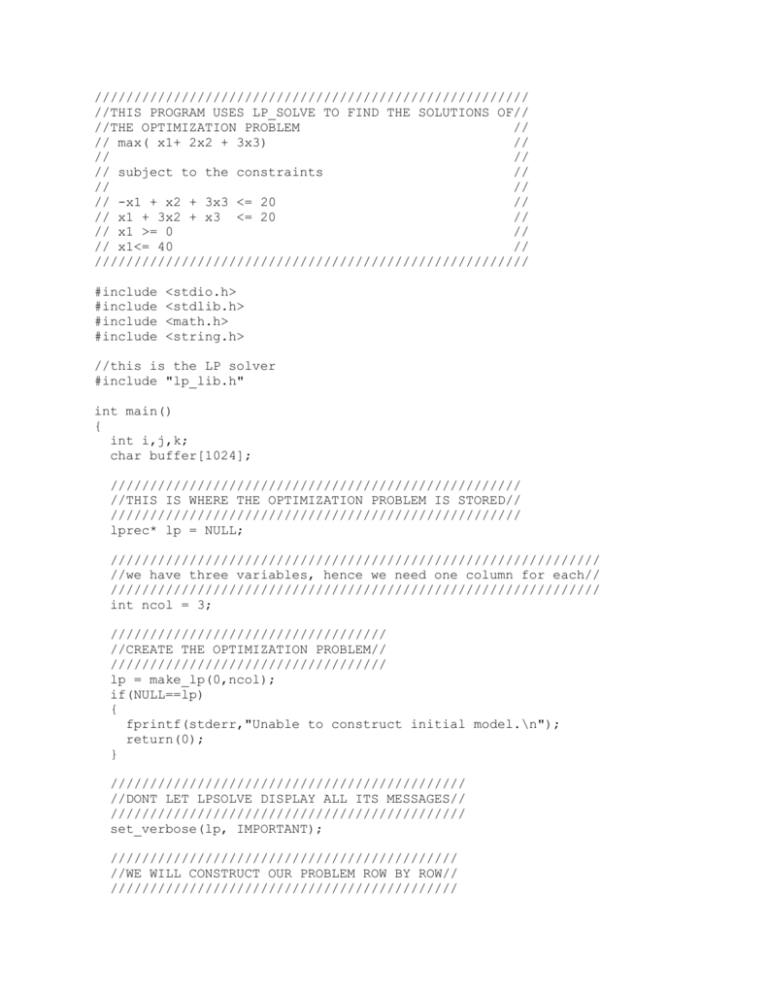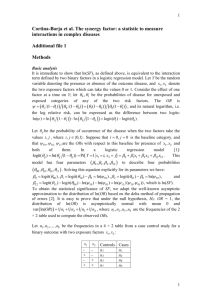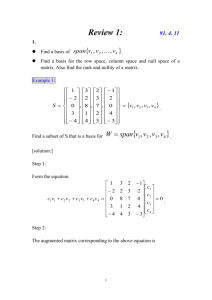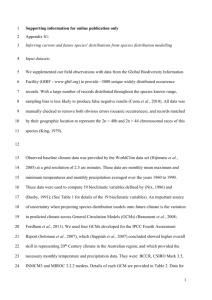
///////////////////////////////////////////////////////
//THIS PROGRAM USES LP_SOLVE TO FIND THE SOLUTIONS OF//
//THE OPTIMIZATION PROBLEM
//
// max( x1+ 2x2 + 3x3)
//
//
//
// subject to the constraints
//
//
//
// -x1 + x2 + 3x3 <= 20
//
// x1 + 3x2 + x3 <= 20
//
// x1 >= 0
//
// x1<= 40
//
///////////////////////////////////////////////////////
#include
#include
#include
#include
<stdio.h>
<stdlib.h>
<math.h>
<string.h>
//this is the LP solver
#include "lp_lib.h"
int main()
{
int i,j,k;
char buffer[1024];
////////////////////////////////////////////////////
//THIS IS WHERE THE OPTIMIZATION PROBLEM IS STORED//
////////////////////////////////////////////////////
lprec* lp = NULL;
//////////////////////////////////////////////////////////////
//we have three variables, hence we need one column for each//
//////////////////////////////////////////////////////////////
int ncol = 3;
///////////////////////////////////
//CREATE THE OPTIMIZATION PROBLEM//
///////////////////////////////////
lp = make_lp(0,ncol);
if(NULL==lp)
{
fprintf(stderr,"Unable to construct initial model.\n");
return(0);
}
/////////////////////////////////////////////
//DONT LET LPSOLVE DISPLAY ALL ITS MESSAGES//
/////////////////////////////////////////////
set_verbose(lp, IMPORTANT);
////////////////////////////////////////////
//WE WILL CONSTRUCT OUR PROBLEM ROW BY ROW//
////////////////////////////////////////////
REAL* row = new REAL[1+ncol];
//////////////////////////////////////////////////
//TELL YOUR PROBLEM YOU ARE PLANNING TO ADD ROWS//
//////////////////////////////////////////////////
set_add_rowmode(lp, TRUE);
/////////////////////////
//ADD THE CONSTRAINT
//
// -x1 + x2 + 3x3 <= 20//
/////////////////////////
memset(row,0,(1+ncol)*sizeof(REAL));
row[1] = -1; // the coefficient of x1
row[2] = 1; //the coefficient of x2
row[3] = 3; //the coefficient of x3
if(!add_constraint(lp, row, LE,20))
{
fprintf(stderr,"Failed to add linear constraint\n");
return(0);
}
/////////////////////////
//ADD THE CONSTRAINT
//
// -x1 + x2 + 3x3 <= 20//
/////////////////////////
memset(row,0,(1+ncol)*sizeof(REAL));
row[1] = 1; // the coefficient of x1
row[2] = 3; //the coefficient of x2
row[3] = 1; //the coefficient of x3
if(!add_constraint(lp, row, LE,20))
{
fprintf(stderr,"Failed to add linear constraint\n");
return(0);
}
/////////////////////////
//ADD THE CONSTRAINT
//
// x1 >= 0
//
/////////////////////////
memset(row,0,(1+ncol)*sizeof(REAL));
row[1] = 1; // the coefficient of x1
if(!add_constraint(lp, row, GE,0))
{
fprintf(stderr,"Failed to add linear constraint\n");
return(0);
}
/////////////////////////
//ADD THE CONSTRAINT
//
// x1 <= 40
//
/////////////////////////
memset(row,0,(1+ncol)*sizeof(REAL));
row[1] = 1; // the coefficient of x1
if(!add_constraint(lp, row, LE,40))
{
fprintf(stderr,"Failed to add linear constraint\n");
return(0);
}
///////////////////////////
//WE ARE DONE ADDING ROWS//
///////////////////////////
set_add_rowmode(lp, FALSE);
//////////////////////////////
//SET THE OBJECTIVE FUNCTION//
//////////////////////////////
////////////////////////////
//SPECIFY THE OBJECTIVE IS//
// (x1+ 2x2 + 3x3)
//
////////////////////////////
memset(row,0,(1+ncol)*sizeof(REAL));
row[1] = 1; // the coefficient of x1
row[2] = 2; //the coefficient of x2
row[3] = 3; //the coefficient of x3
if(!set_obj_fn(lp, row))
{
fprintf(stderr,"Failed to add objective function.\n");
return(0);
}
/////////////////////////////////////
//WE NEED TO MAXIMIZE THE OBJECTIVE//
/////////////////////////////////////
set_maxim(lp);
//////////////////////////////////////////////////
//WRITE THE OPTIMIZATION PROBLEM WE JUST CREATED//
//IN A FILE
//
//////////////////////////////////////////////////
write_lp(lp, "lpex1.lp");
///////////////////////////
//NOW WRITE ON THE SCREEN//
///////////////////////////
write_LP(lp, stdout);
//////////////////////////////////
//SOLVE THE OPTIMIZATION PROBLEM//
//////////////////////////////////
if(OPTIMAL!=solve(lp))
{
fprintf(stderr,"Smth wrong when solving the optimization
problem.\n");
return(0);
}
fprintf(stdout,"The maximum value of objective function is
%.5lf\n",get_objective(lp));
/////////////////////////////////////////////////////////////////////////
//
//OBTAIN THE VALUES OF X1,X2,X3 THAT REALIZE THE MAXIMUM OF THE
OBJECTIVE//
/////////////////////////////////////////////////////////////////////////
//
get_variables(lp, row);
//////////////////////////
//PRINT OUT THEIR VALUES//
//////////////////////////
for(i=0;i<ncol;i++)
{
fprintf(stdout,"x[%d] = %.5lf\n",
i+1,row[i]);
}
///////////////////
//FREE THE MEMORY//
///////////////////
delete[] row; row = NULL;
delete_lp(lp); lp = NULL;
return(1);
}
/* ------------------------------------------------------------------------* File: lpex1.c
* Version 12.1.0
* ------------------------------------------------------------------------* Licensed Materials - Property of IBM
* 5724-Y48
* (c) Copyright IBM Corporation 1997, 2009. All Rights Reserved.
*
* US Government Users Restricted Rights - Use, duplication or
* disclosure restricted by GSA ADP Schedule Contract with
* IBM Corp.
* ------------------------------------------------------------------------*/
/* lpex1.c - Entering and optimizing a problem.
Demonstrates different
methods for creating a problem.
on the command line:
lpex1 -r
lpex1 -c
lpex1 -n
coefficients
*/
The user has to choose the method
generates the problem by adding rows
generates the problem by adding columns
generates the problem by adding a list of
/* Bring in the CPLEX function declarations and the C library
header file stdio.h with the following single include. */
#include <ilcplex/cplex.h>
#include <stdlib.h>
/* Bring in the declarations for the string functions */
#include <string.h>
/* Include declaration for functions at end of program */
static int
populatebyrow
(CPXENVptr env, CPXLPptr lp),
populatebycolumn (CPXENVptr env, CPXLPptr lp),
populatebynonzero (CPXENVptr env, CPXLPptr lp);
static void
free_and_null
usage
(char **ptr),
(char *progname);
int
main (int argc, char **argv)
{
/* Declare and allocate space for the variables and arrays where we
will store the optimization results including the status, objective
value, variable values, dual values, row slacks and variable
reduced costs. */
int
double
double
double
double
double
CPXENVptr
CPXLPptr
int
int
int
solstat;
objval;
*x = NULL;
*pi = NULL;
*slack = NULL;
*dj = NULL;
env = NULL;
lp = NULL;
status = 0;
i, j;
cur_numrows, cur_numcols;
/* Check the command line arguments */
if (( argc != 2 )
||
( argv[1][0] != '-' )
||
( strchr ("rcn", argv[1][1]) == NULL )
) {
usage (argv[0]);
goto TERMINATE;
}
/* Initialize the CPLEX environment */
env = CPXopenCPLEX (&status);
/* If an error occurs, the status value indicates the reason for
failure. A call to CPXgeterrorstring will produce the text of
the error message. Note that CPXopenCPLEX produces no output,
so the only way to see the cause of the error is to use
CPXgeterrorstring. For other CPLEX routines, the errors will
be seen if the CPX_PARAM_SCRIND indicator is set to CPX_ON. */
if ( env == NULL ) {
char errmsg[1024];
fprintf (stderr, "Could not open CPLEX environment.\n");
CPXgeterrorstring (env, status, errmsg);
fprintf (stderr, "%s", errmsg);
goto TERMINATE;
}
/* Turn on output to the screen */
status = CPXsetintparam (env, CPX_PARAM_SCRIND, CPX_ON);
if ( status ) {
fprintf (stderr,
"Failure to turn on screen indicator, error %d.\n",
status);
goto TERMINATE;
}
/* Turn on data checking */
status = CPXsetintparam (env, CPX_PARAM_DATACHECK, CPX_ON);
if ( status ) {
fprintf (stderr,
"Failure to turn on data checking, error %d.\n", status);
goto TERMINATE;
}
/* Create the problem. */
lp = CPXcreateprob (env, &status, "lpex1");
/* A returned pointer of NULL may mean that not enough memory
was available or there was some other problem. In the case of
failure, an error message will have been written to the error
channel from inside CPLEX. In this example, the setting of
the parameter CPX_PARAM_SCRIND causes the error message to
appear on stdout. */
if ( lp == NULL ) {
fprintf (stderr, "Failed to create LP.\n");
goto TERMINATE;
}
/* Now populate the problem with the data. For building large
problems, consider setting the row, column and nonzero growth
parameters before performing this task. */
switch (argv[1][1]) {
case 'r':
status = populatebyrow (env, lp);
break;
case 'c':
status = populatebycolumn (env, lp);
break;
case 'n':
status = populatebynonzero (env, lp);
break;
}
if ( status ) {
fprintf (stderr, "Failed to populate problem.\n");
goto TERMINATE;
}
/* Optimize the problem and obtain solution. */
status = CPXlpopt (env, lp);
if ( status ) {
fprintf (stderr, "Failed to optimize LP.\n");
goto TERMINATE;
}
/* The size of the problem should be obtained by asking CPLEX what
the actual size is, rather than using sizes from when the problem
was built. cur_numrows and cur_numcols store the current number
of rows and columns, respectively. */
cur_numrows = CPXgetnumrows (env, lp);
cur_numcols = CPXgetnumcols (env, lp);
x = (double *) malloc (cur_numcols * sizeof(double));
slack = (double *) malloc (cur_numrows * sizeof(double));
dj = (double *) malloc (cur_numcols * sizeof(double));
pi = (double *) malloc (cur_numrows * sizeof(double));
if ( x
== NULL ||
slack == NULL ||
dj
== NULL ||
pi
== NULL
) {
status = CPXERR_NO_MEMORY;
fprintf (stderr, "Could not allocate memory for solution.\n");
goto TERMINATE;
}
status = CPXsolution (env, lp, &solstat, &objval, x, pi, slack, dj);
if ( status ) {
fprintf (stderr, "Failed to obtain solution.\n");
goto TERMINATE;
}
/* Write the output to the screen. */
printf ("\nSolution status = %d\n", solstat);
printf ("Solution value = %f\n\n", objval);
for (i = 0; i < cur_numrows; i++) {
printf ("Row %d: Slack = %10f Pi = %10f\n", i, slack[i], pi[i]);
}
for (j = 0; j < cur_numcols; j++) {
printf ("Column %d: Value = %10f
j, x[j], dj[j]);
}
Reduced cost = %10f\n",
/* Finally, write a copy of the problem to a file. */
status = CPXwriteprob (env, lp, "lpex1.lp", NULL);
if ( status ) {
fprintf (stderr, "Failed to write LP to disk.\n");
goto TERMINATE;
}
TERMINATE:
/* Free up the solution */
free_and_null
free_and_null
free_and_null
free_and_null
((char
((char
((char
((char
**)
**)
**)
**)
&x);
&slack);
&dj);
&pi);
/* Free up the problem as allocated by CPXcreateprob, if necessary */
if ( lp != NULL ) {
status = CPXfreeprob (env, &lp);
if ( status ) {
fprintf (stderr, "CPXfreeprob failed, error code %d.\n",
status);
}
}
/* Free up the CPLEX environment, if necessary */
if ( env != NULL ) {
status = CPXcloseCPLEX (&env);
/* Note that CPXcloseCPLEX produces no output,
so the only way to see the cause of the error is to use
CPXgeterrorstring. For other CPLEX routines, the errors will
be seen if the CPX_PARAM_SCRIND indicator is set to CPX_ON. */
if ( status ) {
char errmsg[1024];
fprintf (stderr, "Could not close CPLEX environment.\n");
CPXgeterrorstring (env, status, errmsg);
fprintf (stderr, "%s", errmsg);
}
}
return (status);
}
/* END main */
/* This simple routine frees up the pointer *ptr, and sets *ptr to NULL
*/
static void
free_and_null (char **ptr)
{
if ( *ptr != NULL ) {
free (*ptr);
*ptr = NULL;
}
} /* END free_and_null */
static void
usage (char *progname)
{
fprintf (stderr,"Usage: %s -X\n", progname);
fprintf (stderr,"
where X is one of the following options: \n");
fprintf (stderr,"
r
generate problem by row\n");
fprintf (stderr,"
c
generate problem by column\n");
fprintf (stderr,"
n
generate problem by nonzero\n");
fprintf (stderr," Exiting...\n");
} /* END usage */
/* These functions all populate the problem with data for the following
linear program:
Maximize
obj: x1 + 2 x2 + 3 x3
Subject To
c1: - x1 + x2 + x3 <= 20
c2: x1 - 3 x2 + x3 <= 30
Bounds
0 <= x1 <= 40
End
*/
#define NUMROWS
#define NUMCOLS
#define NUMNZ
2
3
6
/* To populate by row, we first create the columns, and then add the
rows. */
static int
populatebyrow (CPXENVptr env, CPXLPptr lp)
{
int
status
= 0;
double
obj[NUMCOLS];
double
lb[NUMCOLS];
double
ub[NUMCOLS];
char
*colname[NUMCOLS];
int
rmatbeg[NUMROWS];
int
rmatind[NUMNZ];
double
rmatval[NUMNZ];
double
rhs[NUMROWS];
char
sense[NUMROWS];
char
*rowname[NUMROWS];
CPXchgobjsen (env, lp, CPX_MAX);
/* Now create the new columns.
obj[0] = 1.0;
lb[0] = 0.0;
ub[0] = 40.0;
/* Problem is maximization */
First, populate the arrays. */
obj[1] = 2.0;
obj[2] = 3.0;
lb[1] = 0.0;
ub[1] = CPX_INFBOUND;
colname[0] = "x1"; colname[1] = "x2";
lb[2] = 0.0;
ub[2] = CPX_INFBOUND;
colname[2] = "x3";
status = CPXnewcols (env, lp, NUMCOLS, obj, lb, ub, NULL, colname);
if ( status ) goto TERMINATE;
/* Now add the constraints.
rmatbeg[0] = 0;
rmatind[0] = 0;
'L';
rmatval[0] = -1.0;
20.0;
*/
rowname[0] = "c1";
rmatind[1] = 1;
rmatind[2] = 2;
sense[0] =
rmatval[1] = 1.0;
rmatval[2] = 1.0;
rhs[0]
=
rmatbeg[1] = 3;
rmatind[3] = 0;
'L';
rmatval[3] = 1.0;
30.0;
rowname[1] = "c2";
rmatind[4] = 1;
rmatind[5] = 2;
sense[1] =
rmatval[4] = -3.0; rmatval[5] = 1.0;
rhs[1]
=
status = CPXaddrows (env, lp, 0, NUMROWS, NUMNZ, rhs, sense, rmatbeg,
rmatind, rmatval, NULL, rowname);
if ( status ) goto TERMINATE;
TERMINATE:
return (status);
}
/* END populatebyrow */
/* To populate by column, we first create the rows, and then add the
columns. */
static int
populatebycolumn (CPXENVptr env, CPXLPptr lp)
{
int
status
= 0;
double
obj[NUMCOLS];
double
lb[NUMCOLS];
double
ub[NUMCOLS];
char
*colname[NUMCOLS];
int
matbeg[NUMCOLS];
int
matind[NUMNZ];
double
matval[NUMNZ];
double
rhs[NUMROWS];
char
sense[NUMROWS];
char
*rowname[NUMROWS];
CPXchgobjsen (env, lp, CPX_MAX);
/* Now create the new rows.
/* Problem is maximization */
First, populate the arrays. */
rowname[0] = "c1";
sense[0]
= 'L';
rhs[0]
= 20.0;
rowname[1] = "c2";
sense[1]
= 'L';
rhs[1]
= 30.0;
status = CPXnewrows (env, lp, NUMROWS, rhs, sense, NULL, rowname);
if ( status )
goto TERMINATE;
/* Now add the new columns.
First, populate the arrays. */
obj[0] = 1.0;
obj[1] = 2.0;
obj[2] = 3.0;
matbeg[0] = 0;
matbeg[1] = 2;
matbeg[2] = 4;
matind[0] = 0;
matval[0] = -1.0;
matind[2] = 0;
matval[2] = 1.0;
matind[4] = 0;
matval[4] = 1.0;
matind[1] = 1;
matval[1] = 1.0;
matind[3] = 1;
matval[3] = -3.0;
matind[5] = 1;
matval[5] = 1.0;
lb[0] = 0.0;
ub[0] = 40.0;
lb[1] = 0.0;
ub[1] = CPX_INFBOUND;
colname[0] = "x1"; colname[1] = "x2";
lb[2] = 0.0;
ub[2] = CPX_INFBOUND;
colname[2] = "x3";
status = CPXaddcols (env, lp, NUMCOLS, NUMNZ, obj, matbeg, matind,
matval, lb, ub, colname);
if ( status ) goto TERMINATE;
TERMINATE:
return (status);
}
/* END populatebycolumn */
/* To populate by nonzero, we first create the rows, then create the
columns, and then change the nonzeros of the matrix 1 at a time. */
static int
populatebynonzero (CPXENVptr env, CPXLPptr lp)
{
int
status
= 0;
double
obj[NUMCOLS];
double
lb[NUMCOLS];
double
ub[NUMCOLS];
char
*colname[NUMCOLS];
double
rhs[NUMROWS];
char
sense[NUMROWS];
char
*rowname[NUMROWS];
int
rowlist[NUMNZ];
int
collist[NUMNZ];
double
vallist[NUMNZ];
CPXchgobjsen (env, lp, CPX_MAX);
/* Now create the new rows.
rowname[0] = "c1";
sense[0]
= 'L';
rhs[0]
= 20.0;
rowname[1] = "c2";
sense[1]
= 'L';
/* Problem is maximization */
First, populate the arrays. */
rhs[1]
= 30.0;
status = CPXnewrows (env, lp, NUMROWS, rhs, sense, NULL, rowname);
if ( status )
goto TERMINATE;
/* Now add the new columns.
obj[0] = 1.0;
lb[0] = 0.0;
ub[0] = 40.0;
First, populate the arrays. */
obj[1] = 2.0;
obj[2] = 3.0;
lb[1] = 0.0;
ub[1] = CPX_INFBOUND;
colname[0] = "x1"; colname[1] = "x2";
lb[2]
ub[2]
= 0.0;
= CPX_INFBOUND;
colname[2] = "x3";
status = CPXnewcols (env, lp, NUMCOLS, obj, lb, ub, NULL, colname);
if ( status ) goto TERMINATE;
/* Now create the list of coefficients */
rowlist[0]
rowlist[1]
rowlist[2]
rowlist[3]
rowlist[4]
rowlist[5]
=
=
=
=
=
=
0;
0;
0;
1;
1;
1;
collist[0]
collist[1]
collist[2]
collist[3]
collist[4]
collist[5]
=
=
=
=
=
=
0;
1;
2;
0;
1;
2;
vallist[0]
vallist[1]
vallist[2]
vallist[3]
vallist[4]
vallist[5]
=
=
=
=
=
=
-1.0;
1.0;
1.0;
1.0;
-3.0;
1.0;
status = CPXchgcoeflist (env, lp, 6, rowlist, collist, vallist);
if ( status )
goto TERMINATE;
TERMINATE:
return (status);
}
/* END populatebynonzero */
16




![[#EL_SPEC-9] ELProcessor.defineFunction methods do not check](http://s3.studylib.net/store/data/005848280_1-babb03fc8c5f96bb0b68801af4f0485e-300x300.png)



![[#CDV-1051] TCObjectPhysical.literalValueChanged() methods call](http://s3.studylib.net/store/data/005848283_1-7ce297e9b7f9355ba466892dc6aee789-300x300.png)
